African Nova Scotian English: Linguistic Analysis and Discussion
VerifiedAdded on 2022/09/25
|6
|1252
|21
Homework Assignment
AI Summary
This assignment analyzes African Nova Scotian English (ANSE), focusing on its linguistic features and sociolinguistic history. The essay begins with a summary of the article by Shana Poplack and Sali Tagliamonte, discussing the origins of ANSE and its relationship to African American Vernacular English (AAVE), particularly in the isolated African Canadian communities of Guysborough, Nova Scotia. The discussion section explores the influence of social status, power dynamics, and language contact on the development of ANSE, contrasting it with other Maritimes dialects. It highlights the preservation of vernacular linguistic features due to limited social interaction between Black settlers and other communities. The personal response reflects on the impact of this research, emphasizing the role of social and cultural perceptions as a barrier to language contact and the unique evolution of ANSE. The analysis provides insights into the impact of racial disparity and diaspora on language evolution.
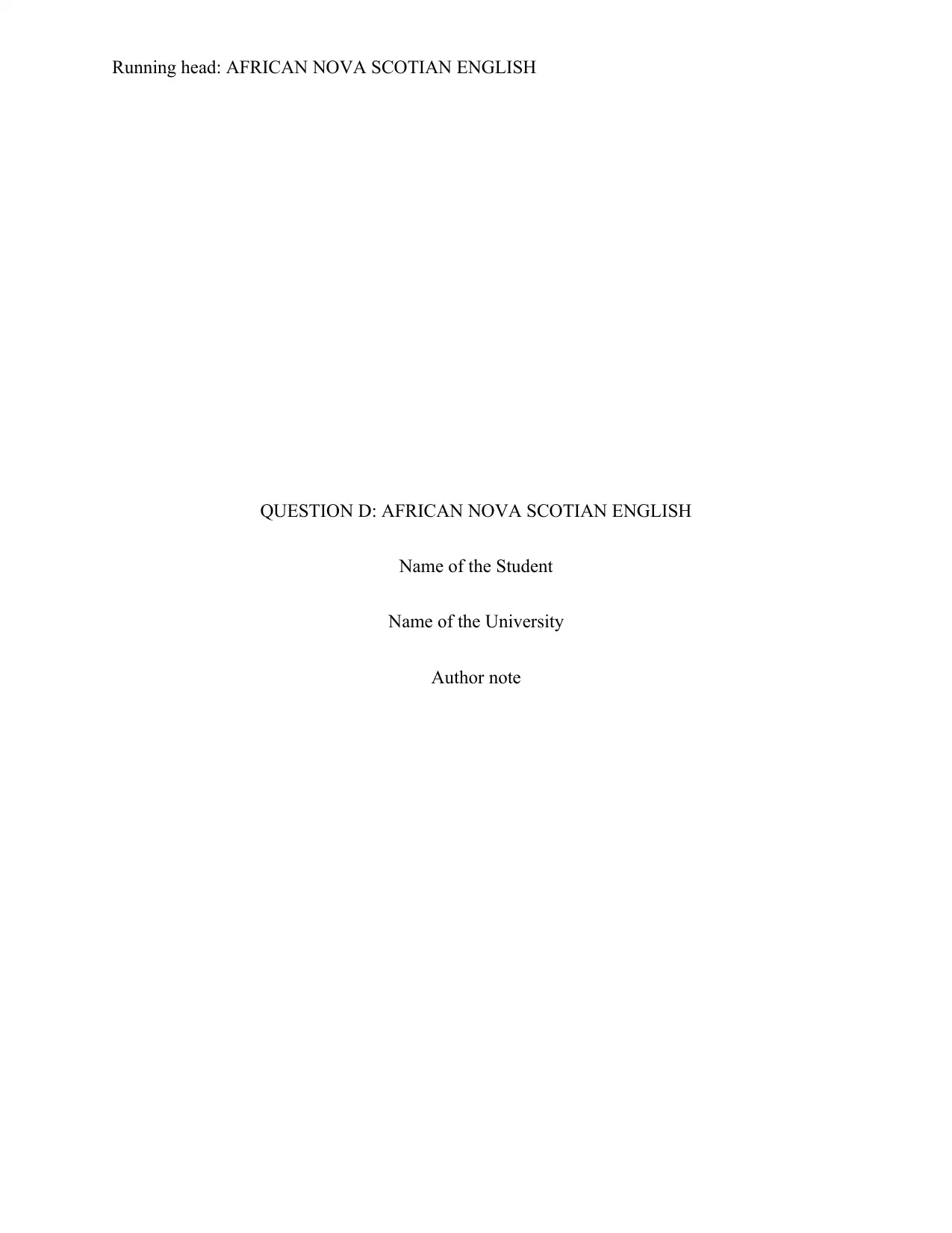
Running head: AFRICAN NOVA SCOTIAN ENGLISH
QUESTION D: AFRICAN NOVA SCOTIAN ENGLISH
Name of the Student
Name of the University
Author note
QUESTION D: AFRICAN NOVA SCOTIAN ENGLISH
Name of the Student
Name of the University
Author note
Paraphrase This Document
Need a fresh take? Get an instant paraphrase of this document with our AI Paraphraser
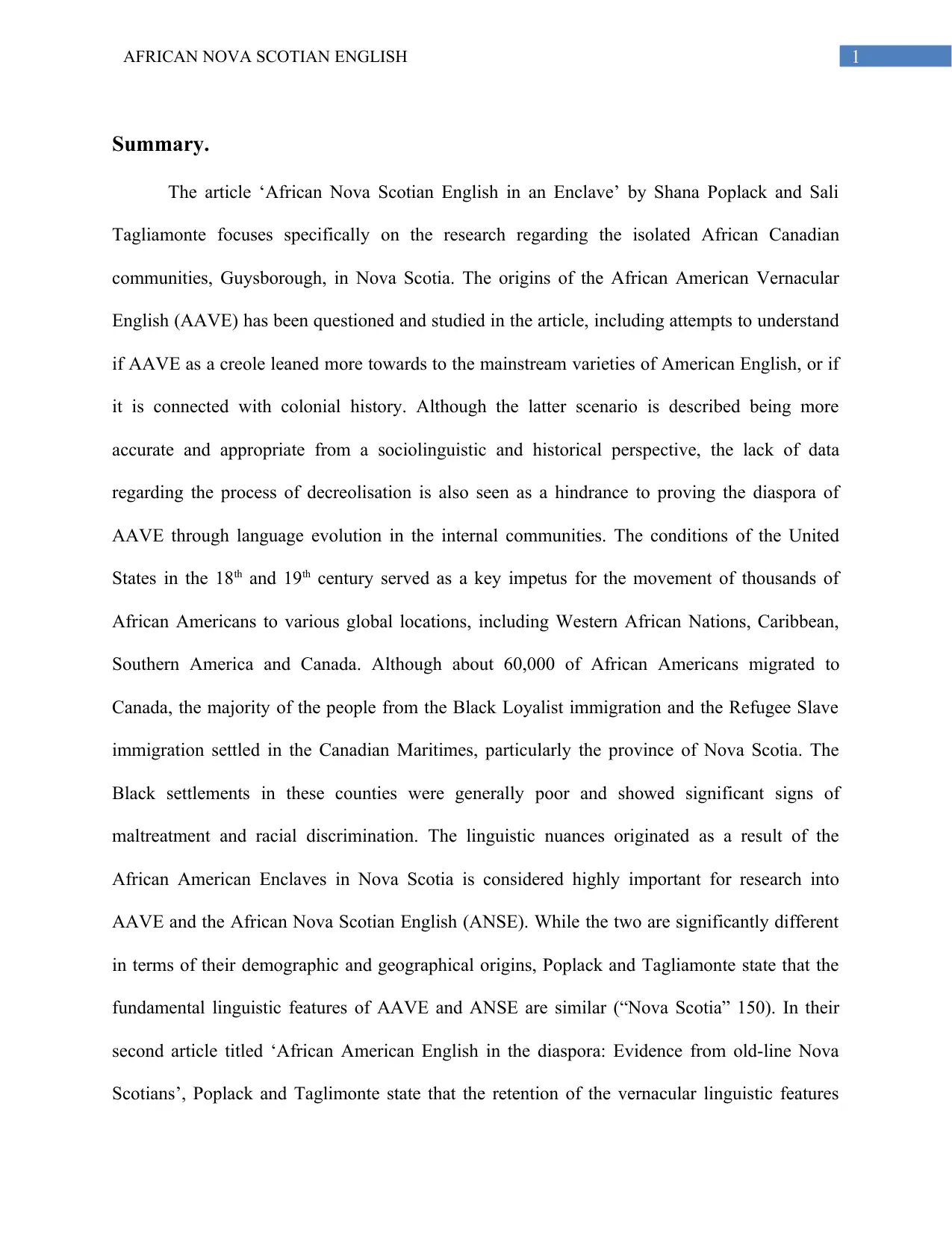
1AFRICAN NOVA SCOTIAN ENGLISH
Summary.
The article ‘African Nova Scotian English in an Enclave’ by Shana Poplack and Sali
Tagliamonte focuses specifically on the research regarding the isolated African Canadian
communities, Guysborough, in Nova Scotia. The origins of the African American Vernacular
English (AAVE) has been questioned and studied in the article, including attempts to understand
if AAVE as a creole leaned more towards to the mainstream varieties of American English, or if
it is connected with colonial history. Although the latter scenario is described being more
accurate and appropriate from a sociolinguistic and historical perspective, the lack of data
regarding the process of decreolisation is also seen as a hindrance to proving the diaspora of
AAVE through language evolution in the internal communities. The conditions of the United
States in the 18th and 19th century served as a key impetus for the movement of thousands of
African Americans to various global locations, including Western African Nations, Caribbean,
Southern America and Canada. Although about 60,000 of African Americans migrated to
Canada, the majority of the people from the Black Loyalist immigration and the Refugee Slave
immigration settled in the Canadian Maritimes, particularly the province of Nova Scotia. The
Black settlements in these counties were generally poor and showed significant signs of
maltreatment and racial discrimination. The linguistic nuances originated as a result of the
African American Enclaves in Nova Scotia is considered highly important for research into
AAVE and the African Nova Scotian English (ANSE). While the two are significantly different
in terms of their demographic and geographical origins, Poplack and Tagliamonte state that the
fundamental linguistic features of AAVE and ANSE are similar (“Nova Scotia” 150). In their
second article titled ‘African American English in the diaspora: Evidence from old-line Nova
Scotians’, Poplack and Taglimonte state that the retention of the vernacular linguistic features
Summary.
The article ‘African Nova Scotian English in an Enclave’ by Shana Poplack and Sali
Tagliamonte focuses specifically on the research regarding the isolated African Canadian
communities, Guysborough, in Nova Scotia. The origins of the African American Vernacular
English (AAVE) has been questioned and studied in the article, including attempts to understand
if AAVE as a creole leaned more towards to the mainstream varieties of American English, or if
it is connected with colonial history. Although the latter scenario is described being more
accurate and appropriate from a sociolinguistic and historical perspective, the lack of data
regarding the process of decreolisation is also seen as a hindrance to proving the diaspora of
AAVE through language evolution in the internal communities. The conditions of the United
States in the 18th and 19th century served as a key impetus for the movement of thousands of
African Americans to various global locations, including Western African Nations, Caribbean,
Southern America and Canada. Although about 60,000 of African Americans migrated to
Canada, the majority of the people from the Black Loyalist immigration and the Refugee Slave
immigration settled in the Canadian Maritimes, particularly the province of Nova Scotia. The
Black settlements in these counties were generally poor and showed significant signs of
maltreatment and racial discrimination. The linguistic nuances originated as a result of the
African American Enclaves in Nova Scotia is considered highly important for research into
AAVE and the African Nova Scotian English (ANSE). While the two are significantly different
in terms of their demographic and geographical origins, Poplack and Tagliamonte state that the
fundamental linguistic features of AAVE and ANSE are similar (“Nova Scotia” 150). In their
second article titled ‘African American English in the diaspora: Evidence from old-line Nova
Scotians’, Poplack and Taglimonte state that the retention of the vernacular linguistic features
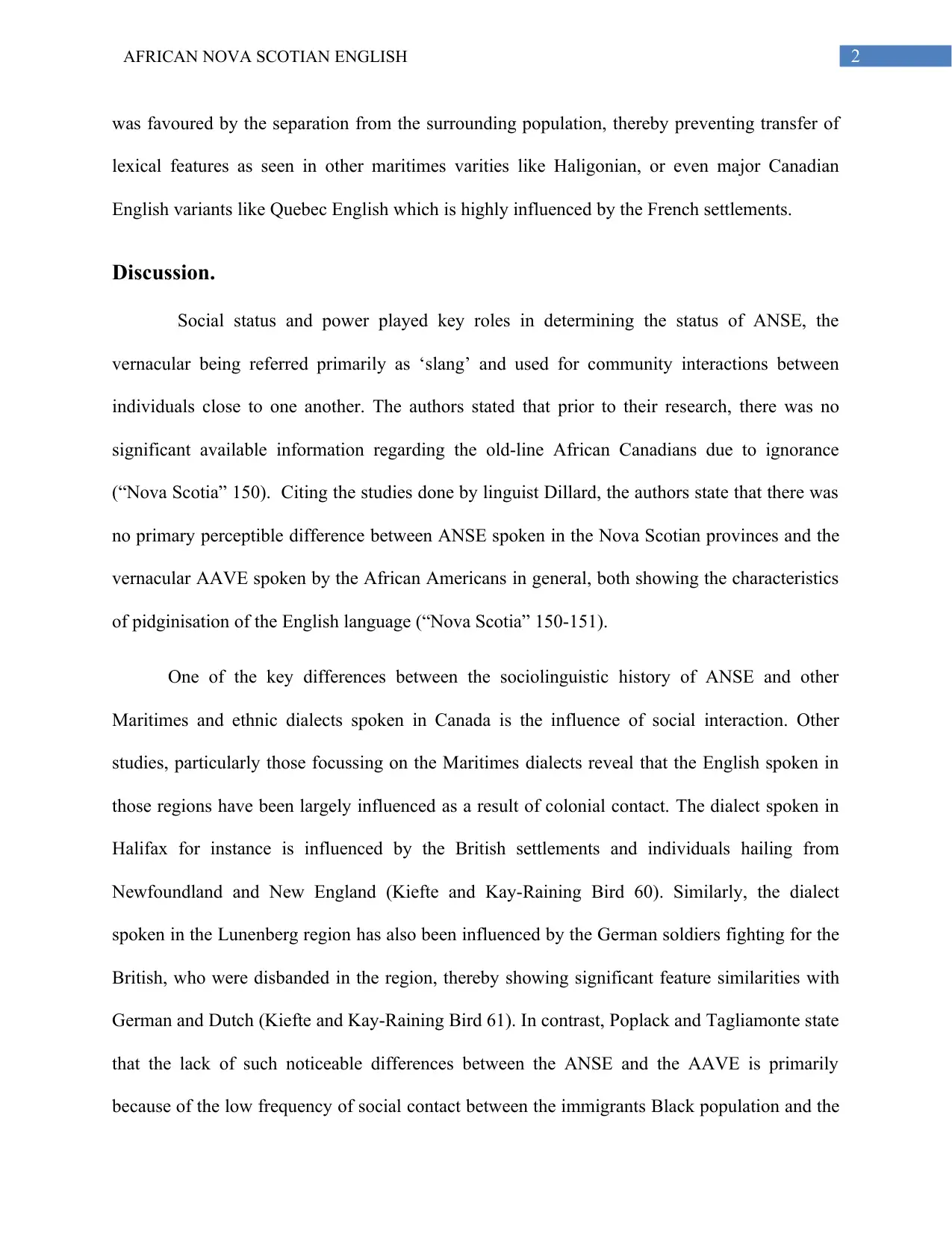
2AFRICAN NOVA SCOTIAN ENGLISH
was favoured by the separation from the surrounding population, thereby preventing transfer of
lexical features as seen in other maritimes varities like Haligonian, or even major Canadian
English variants like Quebec English which is highly influenced by the French settlements.
Discussion.
Social status and power played key roles in determining the status of ANSE, the
vernacular being referred primarily as ‘slang’ and used for community interactions between
individuals close to one another. The authors stated that prior to their research, there was no
significant available information regarding the old-line African Canadians due to ignorance
(“Nova Scotia” 150). Citing the studies done by linguist Dillard, the authors state that there was
no primary perceptible difference between ANSE spoken in the Nova Scotian provinces and the
vernacular AAVE spoken by the African Americans in general, both showing the characteristics
of pidginisation of the English language (“Nova Scotia” 150-151).
One of the key differences between the sociolinguistic history of ANSE and other
Maritimes and ethnic dialects spoken in Canada is the influence of social interaction. Other
studies, particularly those focussing on the Maritimes dialects reveal that the English spoken in
those regions have been largely influenced as a result of colonial contact. The dialect spoken in
Halifax for instance is influenced by the British settlements and individuals hailing from
Newfoundland and New England (Kiefte and Kay-Raining Bird 60). Similarly, the dialect
spoken in the Lunenberg region has also been influenced by the German soldiers fighting for the
British, who were disbanded in the region, thereby showing significant feature similarities with
German and Dutch (Kiefte and Kay-Raining Bird 61). In contrast, Poplack and Tagliamonte state
that the lack of such noticeable differences between the ANSE and the AAVE is primarily
because of the low frequency of social contact between the immigrants Black population and the
was favoured by the separation from the surrounding population, thereby preventing transfer of
lexical features as seen in other maritimes varities like Haligonian, or even major Canadian
English variants like Quebec English which is highly influenced by the French settlements.
Discussion.
Social status and power played key roles in determining the status of ANSE, the
vernacular being referred primarily as ‘slang’ and used for community interactions between
individuals close to one another. The authors stated that prior to their research, there was no
significant available information regarding the old-line African Canadians due to ignorance
(“Nova Scotia” 150). Citing the studies done by linguist Dillard, the authors state that there was
no primary perceptible difference between ANSE spoken in the Nova Scotian provinces and the
vernacular AAVE spoken by the African Americans in general, both showing the characteristics
of pidginisation of the English language (“Nova Scotia” 150-151).
One of the key differences between the sociolinguistic history of ANSE and other
Maritimes and ethnic dialects spoken in Canada is the influence of social interaction. Other
studies, particularly those focussing on the Maritimes dialects reveal that the English spoken in
those regions have been largely influenced as a result of colonial contact. The dialect spoken in
Halifax for instance is influenced by the British settlements and individuals hailing from
Newfoundland and New England (Kiefte and Kay-Raining Bird 60). Similarly, the dialect
spoken in the Lunenberg region has also been influenced by the German soldiers fighting for the
British, who were disbanded in the region, thereby showing significant feature similarities with
German and Dutch (Kiefte and Kay-Raining Bird 61). In contrast, Poplack and Tagliamonte state
that the lack of such noticeable differences between the ANSE and the AAVE is primarily
because of the low frequency of social contact between the immigrants Black population and the
⊘ This is a preview!⊘
Do you want full access?
Subscribe today to unlock all pages.

Trusted by 1+ million students worldwide
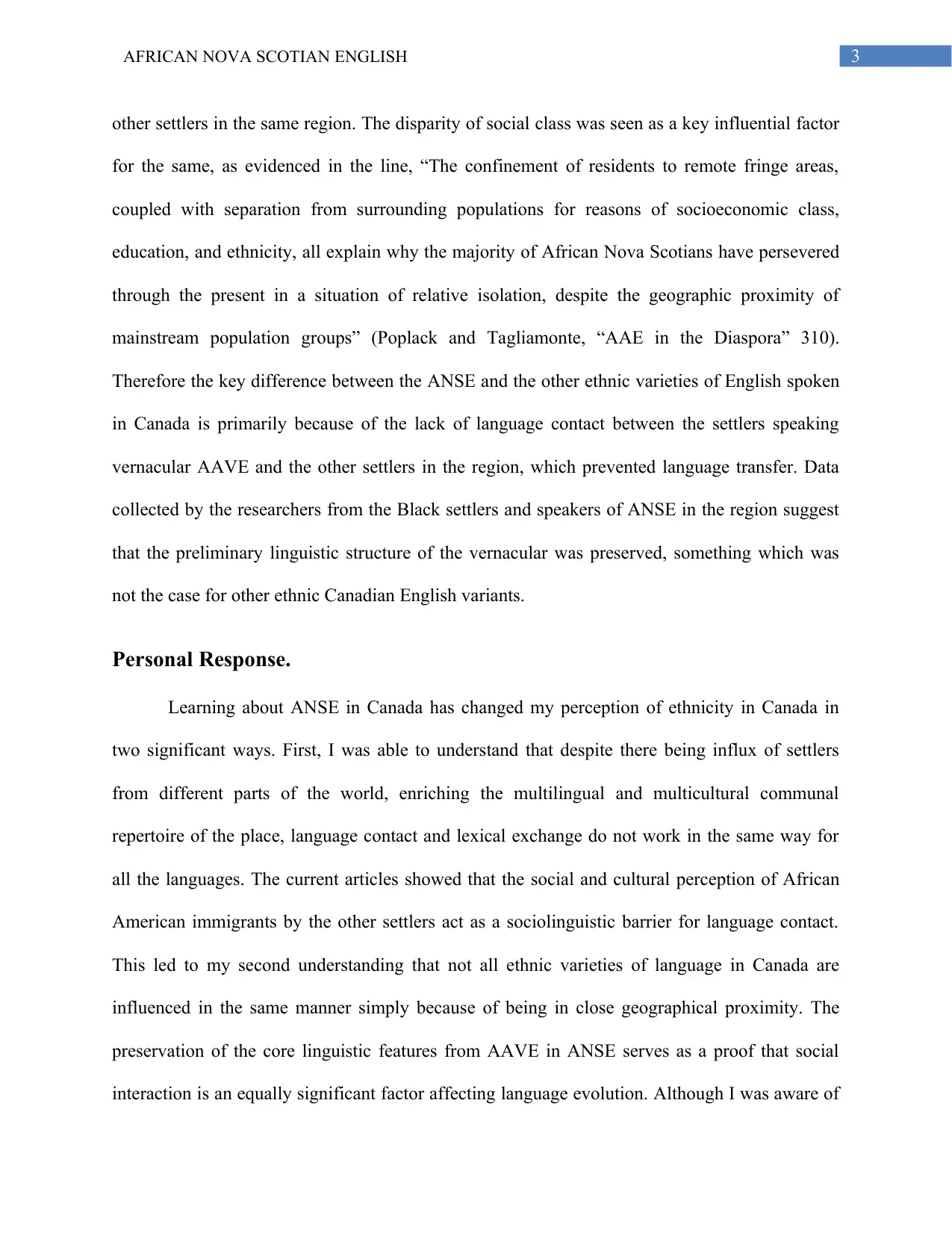
3AFRICAN NOVA SCOTIAN ENGLISH
other settlers in the same region. The disparity of social class was seen as a key influential factor
for the same, as evidenced in the line, “The confinement of residents to remote fringe areas,
coupled with separation from surrounding populations for reasons of socioeconomic class,
education, and ethnicity, all explain why the majority of African Nova Scotians have persevered
through the present in a situation of relative isolation, despite the geographic proximity of
mainstream population groups” (Poplack and Tagliamonte, “AAE in the Diaspora” 310).
Therefore the key difference between the ANSE and the other ethnic varieties of English spoken
in Canada is primarily because of the lack of language contact between the settlers speaking
vernacular AAVE and the other settlers in the region, which prevented language transfer. Data
collected by the researchers from the Black settlers and speakers of ANSE in the region suggest
that the preliminary linguistic structure of the vernacular was preserved, something which was
not the case for other ethnic Canadian English variants.
Personal Response.
Learning about ANSE in Canada has changed my perception of ethnicity in Canada in
two significant ways. First, I was able to understand that despite there being influx of settlers
from different parts of the world, enriching the multilingual and multicultural communal
repertoire of the place, language contact and lexical exchange do not work in the same way for
all the languages. The current articles showed that the social and cultural perception of African
American immigrants by the other settlers act as a sociolinguistic barrier for language contact.
This led to my second understanding that not all ethnic varieties of language in Canada are
influenced in the same manner simply because of being in close geographical proximity. The
preservation of the core linguistic features from AAVE in ANSE serves as a proof that social
interaction is an equally significant factor affecting language evolution. Although I was aware of
other settlers in the same region. The disparity of social class was seen as a key influential factor
for the same, as evidenced in the line, “The confinement of residents to remote fringe areas,
coupled with separation from surrounding populations for reasons of socioeconomic class,
education, and ethnicity, all explain why the majority of African Nova Scotians have persevered
through the present in a situation of relative isolation, despite the geographic proximity of
mainstream population groups” (Poplack and Tagliamonte, “AAE in the Diaspora” 310).
Therefore the key difference between the ANSE and the other ethnic varieties of English spoken
in Canada is primarily because of the lack of language contact between the settlers speaking
vernacular AAVE and the other settlers in the region, which prevented language transfer. Data
collected by the researchers from the Black settlers and speakers of ANSE in the region suggest
that the preliminary linguistic structure of the vernacular was preserved, something which was
not the case for other ethnic Canadian English variants.
Personal Response.
Learning about ANSE in Canada has changed my perception of ethnicity in Canada in
two significant ways. First, I was able to understand that despite there being influx of settlers
from different parts of the world, enriching the multilingual and multicultural communal
repertoire of the place, language contact and lexical exchange do not work in the same way for
all the languages. The current articles showed that the social and cultural perception of African
American immigrants by the other settlers act as a sociolinguistic barrier for language contact.
This led to my second understanding that not all ethnic varieties of language in Canada are
influenced in the same manner simply because of being in close geographical proximity. The
preservation of the core linguistic features from AAVE in ANSE serves as a proof that social
interaction is an equally significant factor affecting language evolution. Although I was aware of
Paraphrase This Document
Need a fresh take? Get an instant paraphrase of this document with our AI Paraphraser
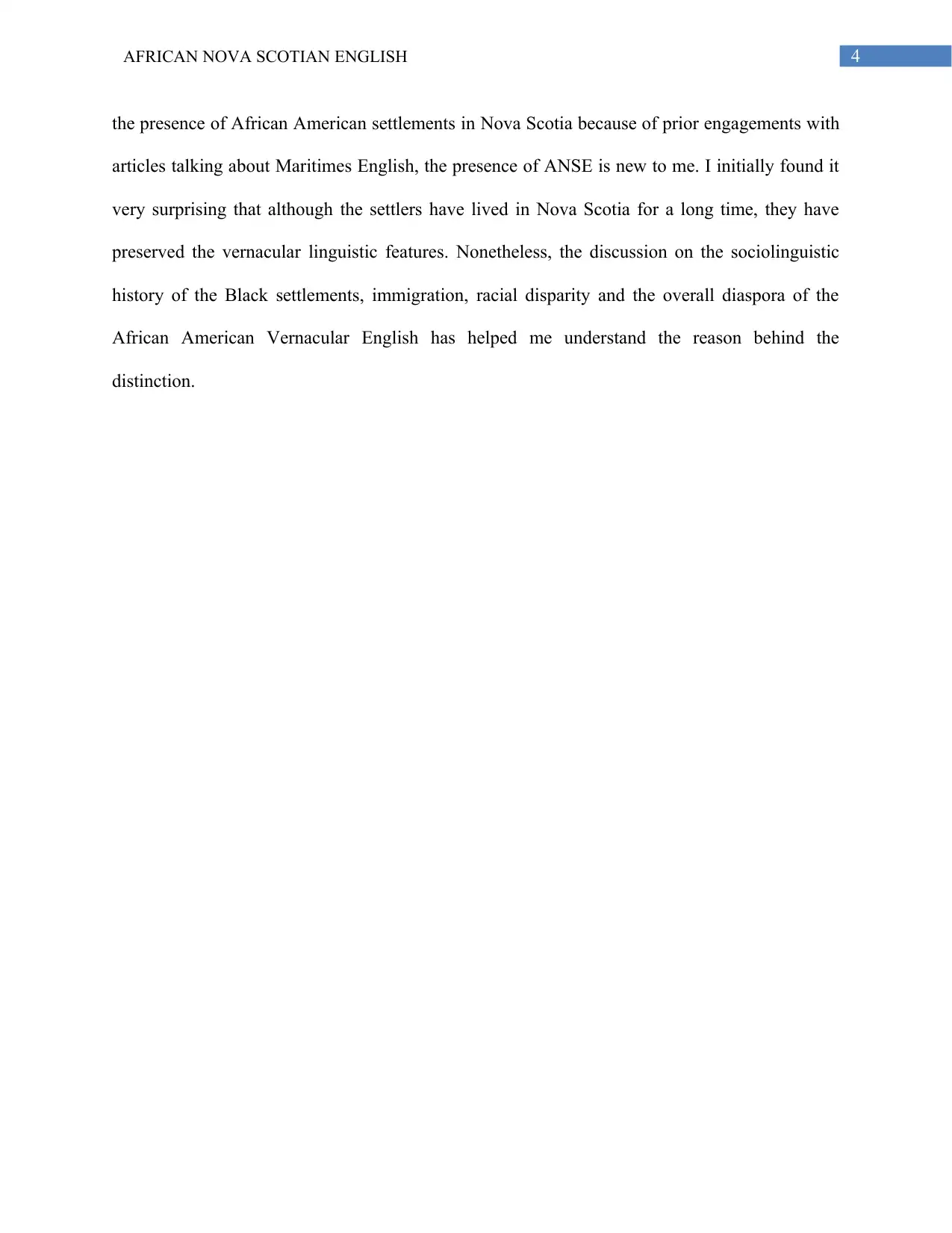
4AFRICAN NOVA SCOTIAN ENGLISH
the presence of African American settlements in Nova Scotia because of prior engagements with
articles talking about Maritimes English, the presence of ANSE is new to me. I initially found it
very surprising that although the settlers have lived in Nova Scotia for a long time, they have
preserved the vernacular linguistic features. Nonetheless, the discussion on the sociolinguistic
history of the Black settlements, immigration, racial disparity and the overall diaspora of the
African American Vernacular English has helped me understand the reason behind the
distinction.
the presence of African American settlements in Nova Scotia because of prior engagements with
articles talking about Maritimes English, the presence of ANSE is new to me. I initially found it
very surprising that although the settlers have lived in Nova Scotia for a long time, they have
preserved the vernacular linguistic features. Nonetheless, the discussion on the sociolinguistic
history of the Black settlements, immigration, racial disparity and the overall diaspora of the
African American Vernacular English has helped me understand the reason behind the
distinction.
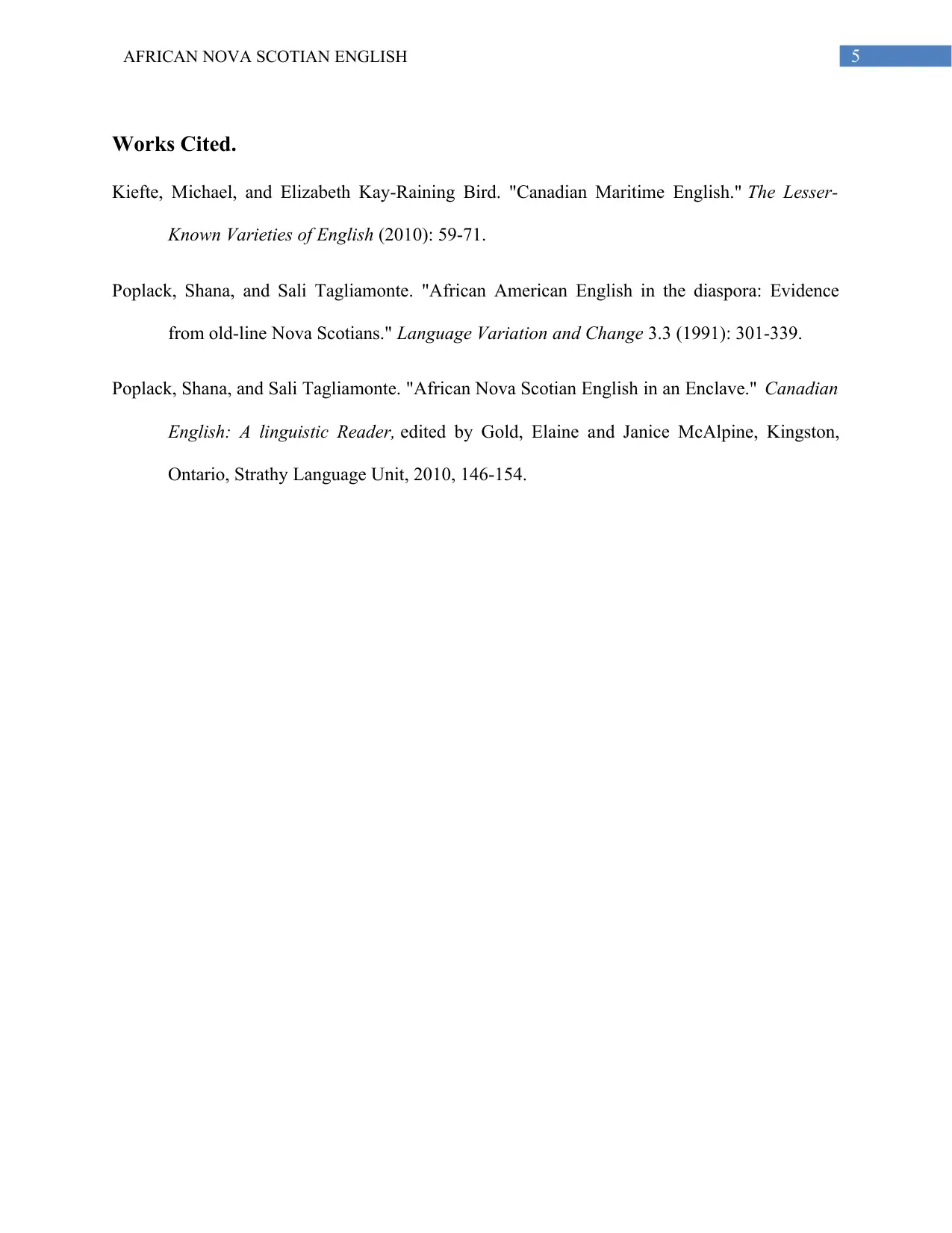
5AFRICAN NOVA SCOTIAN ENGLISH
Works Cited.
Kiefte, Michael, and Elizabeth Kay-Raining Bird. "Canadian Maritime English." The Lesser-
Known Varieties of English (2010): 59-71.
Poplack, Shana, and Sali Tagliamonte. "African American English in the diaspora: Evidence
from old-line Nova Scotians." Language Variation and Change 3.3 (1991): 301-339.
Poplack, Shana, and Sali Tagliamonte. "African Nova Scotian English in an Enclave." Canadian
English: A linguistic Reader, edited by Gold, Elaine and Janice McAlpine, Kingston,
Ontario, Strathy Language Unit, 2010, 146-154.
Works Cited.
Kiefte, Michael, and Elizabeth Kay-Raining Bird. "Canadian Maritime English." The Lesser-
Known Varieties of English (2010): 59-71.
Poplack, Shana, and Sali Tagliamonte. "African American English in the diaspora: Evidence
from old-line Nova Scotians." Language Variation and Change 3.3 (1991): 301-339.
Poplack, Shana, and Sali Tagliamonte. "African Nova Scotian English in an Enclave." Canadian
English: A linguistic Reader, edited by Gold, Elaine and Janice McAlpine, Kingston,
Ontario, Strathy Language Unit, 2010, 146-154.
⊘ This is a preview!⊘
Do you want full access?
Subscribe today to unlock all pages.

Trusted by 1+ million students worldwide
1 out of 6
Your All-in-One AI-Powered Toolkit for Academic Success.
+13062052269
info@desklib.com
Available 24*7 on WhatsApp / Email
![[object Object]](/_next/static/media/star-bottom.7253800d.svg)
Unlock your academic potential
Copyright © 2020–2025 A2Z Services. All Rights Reserved. Developed and managed by ZUCOL.
